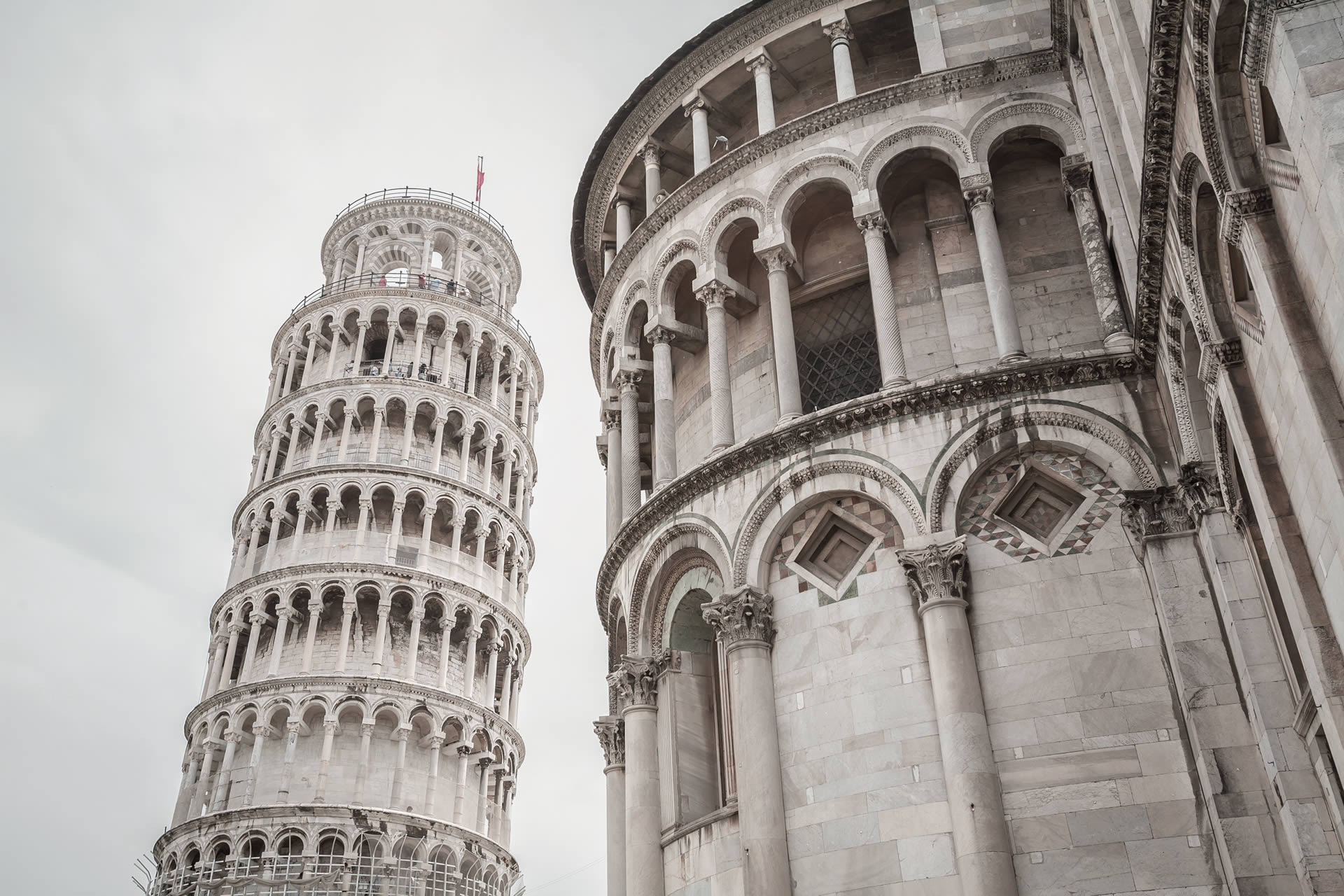
The city of Pisa, located in western Tuscany, is known throughout the world for its famous Leaning Tower. This ecclesiastical city began its life as a seaside settlement around 3,000 years ago and was first laid out in the mid-eleventh century.
Today, Pisa is full of wonderful, historical monuments and buildings dating back many hundreds of years, and much of the city has managed to retain its medieval appearance. Pisa is also known for its excellent University, which was established in 1343 and has become one of Italy's top schools.
Pisa's principal tourist attractions are grouped together in the Campo dei Miracoli or Piazza dei Miracoli, the Field of Miracles. The setting is an immense green lawn at the edge of the town centre on which four impressive buildings stand, in gleaming white marble. These imposing monuments are the enormous, breathtaking Duomo, a grand Romanesque cathedral built almost 1,000 years ago, the circular Baptistry - the largest of its kind in the whole of Italy, the Camposanto - also known as the Holy Field, without doubt one of the most beautiful cemeteries in the world, and, of course, the Leaning Tower.
These remarkable Tuscan buildings combine Moorish, Gothic and Romanesque architectural features.
Surrounding the Camposanto on two sides is the city wall, while two major museums are located to the south. These are the Museo dell'Opera - containing a significant collection of sculptures, paintings and other works relating to the ecclesiastical buildings on the Piazza del Duomo; and the Museo delle Sinopie, with many original sketches in plaster from Camposanto frescoes that were damaged by fire in 1944.
The Leaning Tower of Pisa is not the only building that is no longer standing upright in the city. Unsteady, sandy soil beneath the Field of Miracles has resulted in other problems. The baptistery lurches noticeably towards the north and also, when viewed at certain angles, the Duomo cathedral is far from straight. There are even a couple of small bell towers in Pisa that have also shifted and these have been nicknamed The Other Leaning Towers: Campanile of San Nicola and San Michele degli Scalzi.
The historic city centre of Pisa is concentrated on the north bank of the River Arno and is still surrounded by 12th-century walls. The 'high street' is the long and curving Via Santa Maria, and connects the Campo dei Miracoli with the Lungarno (Embankment). Palaces and mansions still line this street and retain their splendid facades, which date back to the 16th century.
Among the most attractive churches are Santa Maria della Spina, a Gothic masterpiece on the banks of the Arno, and the octagonal Sant'Agata.
The Museo di San Matteo contains art by local artists and others, including the Pisano family, Fra Angelico and Brueghel.
The Knights’ Square (Piazza dei Cavalieri) is one of the most important landmarks in Pisa, and the second main square of the city. After the middle of 16th century the square become the headquarters of the Order of the Knights of St. Stephen. Now it is a centre of education, being the main house of the "Scuola Normale di Pisa", a higher learning institution part of the University. The square, known as Square of the seven streets, lined with splendidly decorated buildings, has for centuries been the political heart of the city. A visit to the Renaissance church of Santo Stefano dei Cavalieri will give you a real insight in the colourful maritime history of the city. It was in this square that in 1406, Florence’s emissary proclaimed the end of the independence of Pisa. One hundred and fifty years later Cosimo I de Medici, Grand Duke of Tuscany, asked his favourite architect Giorgio Vasari to modernise this space in Renaissance style. He dedicated the square to his recently founded military order of the Knights of Saint Stephen, whose duty was to fight the advancing Ottoman Empire.
Palazzo dei Cavalieri was also known as “Palazzo della Carovana” (Palace of the Convoy). This name derives from the three-year training period undertaken by the initiates of the Order, called “la Carovana”. Vasari embellished it with exquisite grafitti, that represent allegorical figures and signs of the zodiac, and the busts of the Grandukes of Tuscany. In front of it stands the huge statue of a victorious Cosimo I proudly ‘squashing’ the head of a dolphin, as a symbol of his naval victories. Today the palace hosts the Normale di Pisa University.
The Church of the Knights of the Holy and Military Order of St. Stephen was also designed by Vasari (1565–1569). It contains Ottoman and Saracen naval banners captured by the Knights of St. Stephen. The ceiling shows off paintings with historical episodes involving the order, like the “Return of the Fleet” from the Battle of Lepanto.
The Palazzo dell’Orologio (Clock Palace) was the seat of the government in Medieval time. It was the setting of the dramatic story of Count Ugolino della Gherardesca, a traitor of the city who was left there to die of hunger with his sons and grandchildren. In one particularly gruesome scene in the Divine Comedy, Dante tells us that he ate them to survive. Today the Palazzo hosts the University library.
If you want to go shopping in Pisa you must not miss a walk on Corso Italia, Borgo Stretto and Borgo Largo, Pisa's most central pedestrian streets. Borgo Stretto and Borgo Largo are definitely the most elegant streets in Pisa, with their medieval arches and Palazzos. Here you can find the most prestigious brands and the city's most expensive and elegant stores.
Corso Italia is a very central street linking Piazza Vittorio Emanuele II and Piazza dei Cavalieri. It is considered as a shopping street since you can find cafés and stores of every kind and for any budget.
It is worthy a visit also the modern Mural of Keith Haring located in the recently restored Vittorio Emanuele square. The theme of the mural is that of peace and harmony in the world, which can be read through the links and divisions between the 30 figures which, like a puzzle, occupy 180 square metres of the south wall of the church of St. Anthony.
Last but not least placed in the south side of the river, there is an ancient restored building called Palazzo Blu. It is named after the sky-blue colour of its façade, dating back to the end of the 18th century. Overlooking the southern embankment of the Arno river, in the very heart of the historic centre of the city, close to the Ponte di Mezzo, or Middle Bridge, and the Gambacorti Palace, hosting the Town Hall, this ancient noble palace was restored by the Fondazione Pisa and is now a modern venue which hosts many wonderful art exhibitions.


